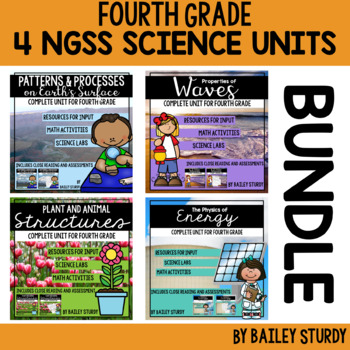4th Grade NGSS Science Unit Bundle
- Zip
What educators are saying
Products in this Bundle (4)
Bonus
Description
Save 25% by buying the bundle!
This bundle includes all 4 units for fourth grade: Energy, Earth Science, Waves, and Plant and Animal Structures.
In this bundle you will find:
Resources for Input
- Inquiry Chart
- Observation Charts
- Big Book (PPT or printable)
- Pictorial and Comparative Input Chart templates (20 total)
- Parts of a Flowering Plant
- The Human Body
- Specialized Sensory Receptors: Cheetah vs Shark
- Earth's Layers
- Topography
- Stratigraphy
- Weathering
- Erosion
- Plate Tectonics
- Anatomy of a Wave
- How Light Helps Us See
- Using Waves to Transfer Information
- Digital vs Analog Radio
- Potential vs Kinetic Energy
- Mechanical Energy Transfer
- Electrical Energy Transfer
- Thermal Energy Transfer
- Conductors vs Insulators
- Energy Transfer in Collisions
- Renewable vs Nonrenewable Energy
- Chants (11 total)
- Sentence Pattern Charts (printable student copies, teacher samples)
- Expert Group Texts:
- Plant Structures (set of 6)
- Animals (set of 6)
- Energy Converting Devices (set of 5)
- Renewable Energy Sources (set of 5)
- Factors Affecting Erosion (set of 6)
- Natural Hazards (set of 6)
- Information Transfer (set of 6)
- Wave Behavior (set of 4)
- Mind Maps to go with Expert Group texts
- Process Grids to go with Expert Group texts
- Writing Prompts for Narrative, Informational, and Opinion text types (12 total)
Math Integration
19 activities total
- 12 center-type activities
- 7 print-and-go activities
Science Labs
26 total. Titles are:
- Flower Dissection
- Celery Stems
- Seed Dissection, Germination, and Tropisms
- Senses Stations
- Learned Behavior Design Challenge
- Energy Scavenger Hunt
- Draw Sankey Diagrams
- Build a Catapult
- Race Car Collisions
- Ice Melt Challenge
- Lemon Clock Design Challenge
- Solar Oven
- Stratigraphy in a Cup
- Weathering and Erosion
- Earth's Layers
- Oreo Plate Tectonics
- Modeling Earth's Shape with Topography
- Landform Lab
- Tsunami Design Challenge
- Wave Models
- Mechanical Waves and Media
- Properties of Light
- RADAR Simulation
- Design Challenge: How We See
- Binary Coding
- Operation: Secret Message
Art Integration
- Printables of over 20 works of art
- Discussion questions for each work connecting art and science
- 4 Art Lessons
Close Reading Sets
12 passages total, each including:
- Essential Question
- Informational Text
- 3 CCSS/DOK Aligned Question Sets
- Journal Prompts (for EQ or DOK 4)
- Titles:
- Photosynthesis
- The Circulatory System
- Pavlov's Dogs // Nobel Prize Speech (paired texts)
- Energy Poverty // A Trip to Africa (paired texts)
- What's the Deal with Fossil Fuels?
- Thomas Edison and the Light Bulb
- The History of the Grand Canyon
- Plate Tectonics
- Mudslides in California // Mud Creek and Big Sur (paired texts)
- The Doppler Effect
- On the Colored Light of Stars
- Animals and Waves
These close readings are available digitally as Google Slides presentations. Within each close reading PDF, there will be a chart with links for presentations with each leveled text, question sets, and journal prompts of the titles.
Note: These are the same close readings in the 4th Grade Close Reading Bundle and the individual close readings. (Waves, Energy, Structures, Earth Processes)
Assessments
5 assessments with answer keys are included.
These are available separately and as their own bundle. Their individual listings are:
- Earth Assessment
- Structures Assessment
- Energy Assessments
- Waves Assessment
- 4th Grade NGSS Assessment Bundle
BONUS: Proficiency Scales that outline exactly what students should know in each unit. These are excellent tools for standards-based report cards.
Please see the previews for the individual files for more information.





